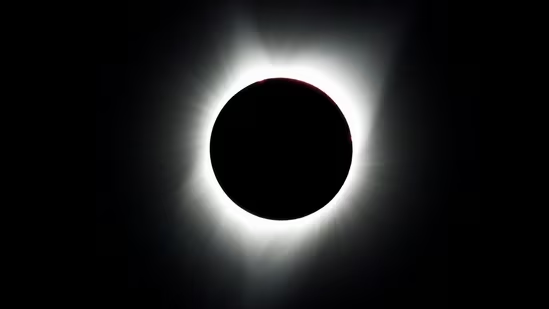2024 Total Solar Eclipse: 10 interesting facts about the natural phenomenon
As North America prepares for its second total solar eclipse in seven years, on April 8, the Moon will cast a shadow over a portion of the Earth that will be shrouded in darkness. Mexico mainland will first witness the astronomical spectacle, which will wrap up the show in Canada. With the Moon moving between the Earth and the Sun, it wraps the solar light and bars us from its direct view. The once-in-a-blue-moon alignment makes the two bodies appear similarly sized in the sky. The complete eclipse begins with its partial counterpart until the Moon fully shields the Sun. According to NASA, this phenomenon lasts for about 70 to 80 minutes. Totality occurs when the Moon blocks the Sun entirely.

Interesting facts about Solar Eclipse
- Solar eclipse as an omen
According to ancient Greece's lore, solar eclipses were perceived as ill omens because they were seen as a symbol of gods' anger. Hence, the word's Greek origins - ‘ekleipsis’ - which refers to “being abandoned.”
- Total solar eclipses are seen only on Earth
Earth is the only planet in our solar system that witnesses a perfect total solar eclipse due to the relative size and distance ratio of the Sun and the Moon from the planet. No other planet's Moon is of a similar size to facilitate the phenomenon.
Also read | Ozempic faces multiple lawsuits over dangerous side effects, here's what to know
- No Total Solar Eclipses in about 600 years
Richard Vondrak, NASA's Goddard Space Flight Centre lunar scientist, had previously described a total eclipse as “a dance with three partners: the moon, the sun and Earth.” He also affirmed, “About 600 million years from now, Earth will experience the beauty and drama of a total solar eclipse for the last time.” Total solar eclipses occur because of the Moon and the Sun's relative size and distance. While the Sun is about 400 times wider than the Moon, the latter is about 400 times closer to the Earth - both bodies appear to have the same sky. However, a NASA statement addressed the growing distance - about 1.5 inches per year - between the Moon and Earth, affecting the resulting total solar eclipse due to the diminished size of the Moon in the sky. Therefore, “over time, the number and frequency of total solar eclipses will decrease.”
- The 2024 totality will be the longest one since 2010
Nazas in Mexico will experience the greatest eclipse duration on April 8, with 4 minutes and 28 seconds of totality. This will exceed the 4 minutes and 40 seconds of totality witnessed by Rapa Nui in July 2010. The 2027 total solar eclipse is estimated to last 6 minutes and 23 seconds in Egypt.
- Saros cycle: The same overlapping pattern will recur in 2042
Every 18 years, 11 days and eight hours, the same alignment between the Sun, Moon and Earth results in a similar solar eclipse. The April 8, 2024, alignment will similarly repeat its pattern on April 20, 2042.
- First total solar eclipse in the continent US in 7 years
North America's last total solar eclipse happened on August 21, 2017. Seven years ago, it traversed from Oregon to South Carolina. The next one will be witnessed 20 years later, on August 23, 2044.
- A solar eclipse occurs only during one lunar phase - the New Moon. However, not every New Moon brings about a solar eclipse.
- The Sun's corona, i.e. the outermost part of its atmosphere, can be viewed only during a total solar eclipse. Since the corona is shrouded in the Sun's bright light, it's impossible to see it with the naked eye. During a total solar eclipse, the Moon shields the Sun's ferocious brightness, allowing the corona's white light to be seen as the Moon appears like a black disk over the Sun.
- Solar eclipse results in two parts of the Moon's shadow: the umbra (darker inner shadow) and penumbra (fainter outer shadow). The Sun's light is entirely blocked in the umbra, so the observers must be within this phase of the shadow to observe a total solar eclipse. Those in the penumbra see a partial eclipse; outside the Moon's shadow, there will be no eclipse.
- In contrast to the total solar eclipse, an annular solar eclipse doesn't fully cover the Sun's disk. When this happens, the Sun's outer edge is visible as an “annulus” or bright ring, also referred to as the “Ring of Fire” effect. Since the Moon's orbit is elliptical and not a perfect circle, its distance from the Earth varies according to its location. Apogee is observed as the farthest point from Earth in the orbit, where the Moon appears smaller. During the annular solar eclipse, the Moon covers the Sun while it's at or near the apogee.
Disclaimer: The copyright of this article belongs to the original author. Reposting this article is solely for the purpose of information dissemination and does not constitute any investment advice. If there is any infringement, please contact us immediately. We will make corrections or deletions as necessary. Thank you.
Title:2024 Total Solar Eclipse: 10 interesting facts about the natural phenomenon
Url:https://www.investsfocus.com







